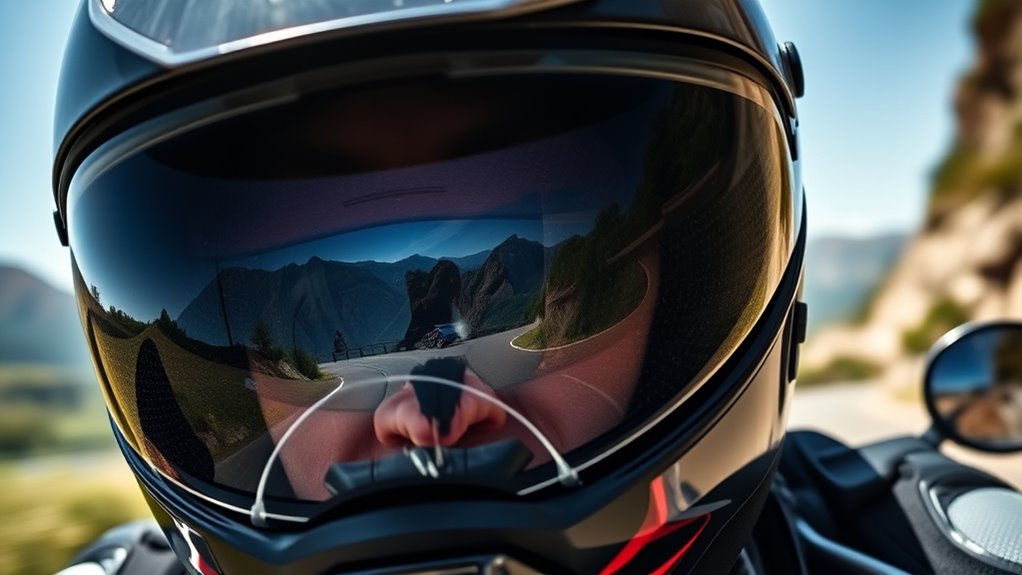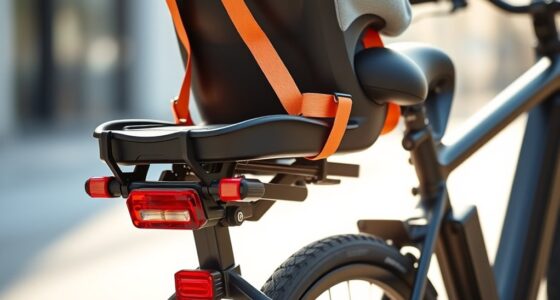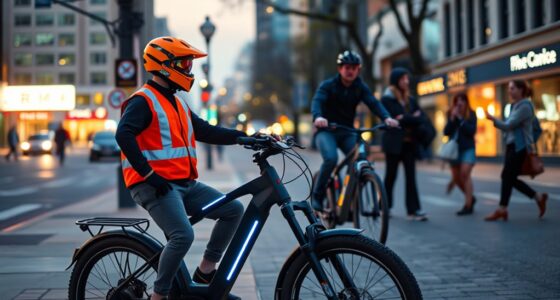Wearing eye protection while riding is essential to keep your eyes safe from glare, harmful UV rays, debris, and insects that can impair your vision and increase your risk of accidents. Proper sunglasses or goggles help you see clearly, reduce eye strain, and improve overall safety. If you want to learn why investing in quality eye protection makes a difference and how to choose the right gear, keep exploring for practical tips.
Key Takeaways
- Sunglasses reduce glare and improve visibility, making riding safer and more comfortable in bright conditions.
- Protecting your eyes from UV rays prevents long-term damage and maintains eye health.
- Proper eye protection decreases eye strain and fatigue during extended rides.
- Well-fitting sunglasses prevent distraction and ensure safety without interfering with helmet fit.
- Eye protection helps detect obstacles and terrain changes, enhancing overall riding awareness.

Have you ever considered how much your eyes are exposed to when you’re riding? The sun’s glare, dust, debris, and wind can all take a toll on your eyesight if you’re not properly protected. While many riders focus on their helmets for safety, neglecting eye protection can be a serious oversight. Wearing sunglasses isn’t just about style; it offers real benefits that enhance your riding experience and safeguard your vision. Sunglasses benefits include reducing glare, blocking harmful UV rays, and improving visibility in bright conditions. When you ride, sunglasses help you see clearly without squinting, which decreases eye strain and fatigue. Plus, darkened lenses can improve contrast and clarity, making it easier to spot obstacles or changes in terrain. But not all sunglasses are created equal, and it’s vital to choose a pair that’s compatible with your helmet. Helmet compatibility is essential because the glasses need to fit comfortably and securely without interfering with your helmet’s fit or safety features. Look for sunglasses with a snug but comfortable fit, especially around the temples, so they stay in place even on bumpy rides. Some riders prefer wraparound styles that provide better coverage and stay put during vigorous movement, while others opt for lighter frames if they wear the glasses for extended periods. Ensuring your sunglasses don’t press uncomfortably against your temples or slide down your nose is key, especially when combined with a helmet. You want your gear to work together seamlessly, not cause discomfort or distraction. Remember, the right sunglasses should complement your helmet, not hinder its fit or your safety. If you’re using prescription eyewear, consider clip-ons or glasses designed specifically for active use, so you don’t have to compromise on vision correction or protection. The combination of sunglasses benefits and helmet compatibility means you’ll enjoy a more comfortable, safer ride. Proper eye protection doesn’t have to be complicated or cumbersome; it’s about selecting gear that enhances your safety without sacrificing comfort. When your sunglasses fit well and provide the necessary coverage, you’re less likely to experience fatigue or distraction. This can ultimately improve your awareness, reaction time, and overall riding confidence. Additionally, understanding the importance of Rhythm Failure can motivate riders to stay vigilant and prioritize safety gear. So, don’t underestimate the importance of eye protection—your eyes are one of your most valuable assets on the road. Invest in quality sunglasses that suit your riding style and helmet, and enjoy the ride knowing your vision is protected from the elements and hazards. Protecting your eyes isn’t just a precaution; it’s a smart, practical step toward safer, more enjoyable riding experiences.
Frequently Asked Questions
Can Contact Lenses Replace Safety Glasses During Riding?
While contact lens safety has improved, they shouldn’t replace riding eye protection. Contact lenses don’t shield your eyes from debris, wind, or insects, which are common risks while riding. Safety glasses or goggles provide a vital barrier against these hazards, keeping your eyes safe. So, even if you wear contacts, always wear proper riding eye protection to prevent injury and guarantee clear vision during your ride.
Are Tinted Visors Suitable for Night Riding?
Tinted visors are generally not suitable for night riding because they can impair your night vision and reduce glare reduction. When riding at night, you need clear visibility to spot obstacles and other vehicles. Tinted visors may make it harder to see in low light, increasing your risk. For safe night riding, opt for a clear visor that enhances your vision and minimizes glare without compromising safety.
How Often Should I Replace My Riding Eye Protection?
You might wonder how often to replace your riding eye protection, and the truth is, it depends. Proper fit guarantees comfort and safety, while lens durability keeps your vision clear. Check your gear regularly for scratches, cracks, or fogging—these signs mean it’s time for a new pair. Typically, replacing your eye protection every 1-2 years or after an impact helps maintain ideal safety and clarity while riding.
Do Polarized Lenses Improve Visibility While Riding?
Polarized lenses can substantially improve visibility while riding by reducing polarized glare from reflective surfaces like water or wet roads. This glare often causes eye strain and hampers your ability to see clearly. With polarized lenses, you’ll notice enhanced clarity and contrast, making it safer and more comfortable to ride in bright conditions. So, if you want better visibility and reduced eye fatigue, polarized lenses are a smart choice for riding.
Are There Specific Eye Protection Requirements for Different Riding Terrains?
When riding, your eye protection needs depend on your riding environment and safety standards. Whether you’re on a sunny trail, rainy road, or dusty path, you should choose gear suited to each terrain. Clear, tinted, or polarized lenses help you see better and stay protected. Always follow safety standards, because proper eye protection prevents injuries and enhances your riding experience across different terrains. Be prepared for whatever environment you encounter.
Conclusion
So, next time you hop on your bike, remember that eye protection isn’t just about shielding against dirt or bugs. It’s about safeguarding your vision from surprises—like a sudden gust or a stray pebble—that can turn a fun ride into a disaster. Just like wearing a helmet, eye protection becomes a simple habit that keeps your adventure safe and enjoyable. Don’t let a blink of an eye ruin your ride; gear up and ride confidently.









